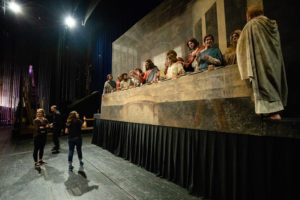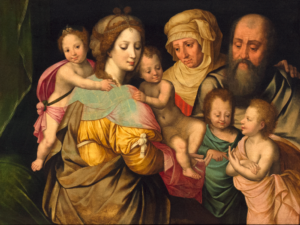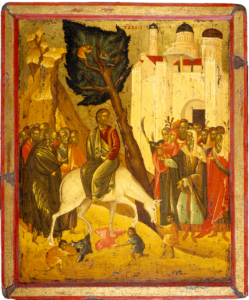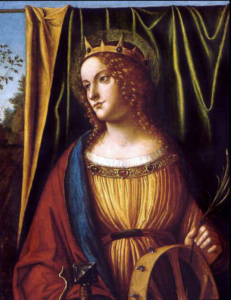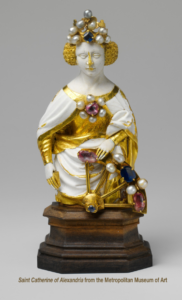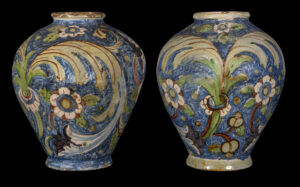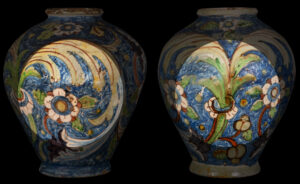Seamlessly support M&G’s mission, collections, and programming by making a recurring donation today!
Category Archives: Instagram
Cassone
Walnut and pastiglia
Italian, 15th century
The antique furnishings in the Museum & Gallery collection elevate each visitor’s experience of the artwork on the walls, but the pieces also provide a historical context of the eras and cultures from which the artworks sprang. Indeed, the furnishings are also artworks in themselves.
This is certainly true of the many cassoni (plural of the Italian term for “chests”) in the collection. Like other furnishings in Renaissance homes, the quality of workmanship and materials employed in decorating each cassone convey a great deal about the fashion of their times, the technologies available to craftsmen, and the wealth and social status of their owners.
Unfortunately, much has gone against their survival to our day. Cassoni were used for storage of personal items, opened and closed numerous times over the years. That wear, along with the environment in a home, infestations of termites, dry rot, changes in taste and reversals of family fortunes all conspire against the preservation of these furnishings.
These rich, showy Italian types of chests became widespread in Northern and Central Italy, particularly Tuscany (with a number of the best artists hailing from the cities of Siena and Florence). Weddings served as the occasions for which cassoni were made, and they were in fashion from the 14th-16th centuries, a period spanning the very late-Middle Ages to the beginning and middle of the Renaissance. The oldest surviving cassoni feature primitive panel designs, while later works demonstrate lavish carving, gilding, polychrome, and more complex narrative scenes.
Much like moving trucks, boxes, and barrels accompanying the establishment of new homes, cassoni had a very specific use. Practically speaking, the chests were designed to contain the bride’s dowry and jewels, her family’s contribution to the marriage, and became one of the couple’s most important household furnishings—often at the foot of the bed. They quite literally became a vehicle displaying the status, wealth and sophistication of the intermarrying families, carried in a procession (the domum ductio) from the bride’s parent’s home to her groom’s abode.
Decoratively speaking, cassoni often feature heraldic imagery relating to the families’ crests, and the pictorial panels often contained biblical, mythological, or allegorical imagery which ranged from learned and literary to humorous and light-hearted. Cassoni themselves were so common in the early- and middle-Renaissance that they’re included in Old Master paintings (most familiar may be scenes of the Annunciation in which Mary is seated on or kneeling near a cassone situated at the foot of her curtained bed) and even picture-within-picture vignettes on cassoni panels themselves.
This particular M&G cassone entered the collection in 1957, and its features suggest a date very early after 1400, likely from Tuscany. Unlike many cassoni today, which have the panels removed and presented as separate works of art in their own right, our chest is in good original condition and is structurally sound, despite surviving 600 years of use and change. The lid is still attached with its original hinges and has a simple locking mechanism. While the lid opens and closes easily, the tight fit and years of use have worn off some of the gesso along the top edge.
Composed of thick walnut planks and framing, the chest has a large front center panel decorated with gilt and polychrome over trellis-embossed gesso. Heraldic lions (possibly leopards or even hunting dogs) face each other across the front, and the two vertical end panels blossom with delicate arabesques and outline colored shields, which likely contained familial coats of arms.
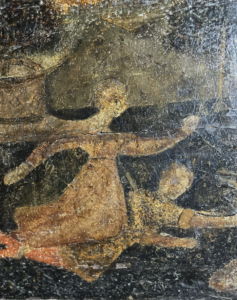 Carved, fluted pilasters frame the two pictorial end panels and are topped with vague Corinthian capitals. The primitive-style narrative at the right end is now entirely obscured, but the imagery at the opposite end remains. The subject matter is indistinct and may be biblical or mythological. Most likely, perhaps, it is the myth of Diana (Artemis) and Actaeon, from Ovid’s Metamorphoses, in which the bathing goddess is startled by a young hunter. In her anger, Diana turns Actaeon into a stag who is then hunted and killed by his own hounds. This identification seems to make sense of the simplistic representation of forest, pool, a stag’s head (lower right) and a hound in the left background. As an allegory or fable for a young couple, it may emphasize modesty, self control, and consequences for the lack of either or both.
Carved, fluted pilasters frame the two pictorial end panels and are topped with vague Corinthian capitals. The primitive-style narrative at the right end is now entirely obscured, but the imagery at the opposite end remains. The subject matter is indistinct and may be biblical or mythological. Most likely, perhaps, it is the myth of Diana (Artemis) and Actaeon, from Ovid’s Metamorphoses, in which the bathing goddess is startled by a young hunter. In her anger, Diana turns Actaeon into a stag who is then hunted and killed by his own hounds. This identification seems to make sense of the simplistic representation of forest, pool, a stag’s head (lower right) and a hound in the left background. As an allegory or fable for a young couple, it may emphasize modesty, self control, and consequences for the lack of either or both.
This cassone provides insight into the artistry, fashion, and domestic life of those living in the early years of the Italian Renaissance and is a valuable part of the M&G collection.
Dr. Stephen B. Jones, M&G volunteer
Additional Resources:
The Oxford History of Western Art. Kemp, Martin, ed. Oxford University Press, 2000.
Pooley, Eugene. “Scenes from a Marriage.”
https://blog.dorotheum.com/en/classic-week-florentine-school/
https://www.medieval.eu/bridal-chests-or-cassoni-from-medieval-italy/
Published 2023
Join Greenville’s leading Easter tradition–attend the annual Living Gallery!
The program varies from year to year. So, come and be challenged and inspired by the drama, uplifting music, and life-size re-creations of great masterpieces (with live models) that make up the Living Gallery, an annual Upstate tradition since 1998.
Location: Rodeheaver Auditorium, campus of Bob Jones University
Parking: Parking is available on the campus of Bob Jones University.
Performance Times:
Thursday, April 17, 2025 at 4:30 and 7:30 PM
Friday, April 18, 2025 at 4:30 and 7:30 PM
Saturday, April 19, 2025 at 2:00, 4:30, and 7:30 PM
Living Gallery Tickets:
Teens & Adults: $19.79 and Children (Ages 6-12): $17.70
- Tickets are on sale at Programs & Productions, in the lobby of Rodeheaver Auditorium, campus of Bob Jones University
- Box Office Hours: Monday-Friday, 12PM to 5PM
- You may begin purchasing tickets in August.
- Call (864) 770-1372, Monday-Friday, 12PM to 5PM
- Learn more about the program here.
Related Offerings:
Bringing a church group? Schedule a tour to see selections of M&G’s collection here.
Want to see works from M&G’s Collection? See the campus locations displaying selections here.
To view a selection of videos featuring Easter-themed works in the Collection, visit here.
Enjoy this series of segments highlighting Picture Books of the Past: Reading Old Master Paintings, a loan exhibition of 60+ works from the M&G collection. The exhibit has traveled to The Museum of the Bible in Washington, D.C. and the Orlando Museum of Art in Florida.
Gustave Doré was a prolific painter, illustrator, engraver, and sculptor. He published his first drawings at age 15 and went on to become the most sought-after illustrator of the mid-19th century.
Majolica Vases
Glazed terracotta
Italian, 16th or 17th century
Earthenware that has been coated with a white glaze and then decorated with other pigmented glazes was first made in Africa around the 6th century. By the 13th century multi-colored designs were possible. A final clear glaze added luster and insured the pieces were watertight. Large quantities of decorative earthenware were produced in Africa and Spain and passed through ports on the island of Majorca on their way to Italy. Thinking the colorfully painted pieces had originated in Majorca, Italians called them majolica.
By the 16th century, techniques for producing majolica had reached Italy. As would be expected, Italian ceramicists stretched the artistic limits of the medium. Although many early majolica pieces were purely functional and received little decoration, others were elaborately decorated and served as status symbols. In wealthy homes large collections of vibrant dishes, bowls, platters, pitchers, jars, and vases were displayed and used to impress guests.
However, many Renaissance majolica containers were used for storage. In the kitchen, these useful jars stored liquids, grains, nuts, dried fruits and the like. What an apothecary of the period might keep in one can only be imagined. Generally larger majolica containers did not have lids. They usually have a short neck, and the opening has an everted edge, allowing the jar to be covered with cloth, paper, or leather and tied in place over the mouth with a string or strap around the jar’s neck.
Smaller Renaissance majolica containers were rectangular boxes or cylinders with concave sides. The lack of handles permitted them to be stored close together on a shelf, and their shape allowed handling without slipping. Larger vessels were generally spherical or, like M&G’s, ovoid with the smaller end toward the bottom. Today these larger containers are often called majolica vases, though their original purpose wasn’t decorative.
Smaller majolica vases could be picked up by putting hands under the wide part of the vase. M&G’s 15½-inch tall and 13-inch diameter vases are considered large. Each vase weighs nearly 12 lbs. and holds about 4.5 gallons of liquid. A full vase would weigh nearly 50 lbs., which would require considerable strength and balance to lift and carry.
M&G’s Majolica Vases have a 5-inch diameter opening. Although the rounded lips would aid in pouring, the mouth is wide enough for a hand or a ladle to access the contents.
The decoration on M&G’s vases includes white, daisy-like flowers with a blue ring around the darker center. These flowers with scrolling foliage (sometimes protruding through the flower) and swirling, plume-like shapes are common on Italian Renaissance containers. The blue background would have been painted after the design of the floral decoration. The short, irregular white curves were inscribed into the blue areas before it was fired. Because of the stability of the pigments and the clear glaze, the colors are still vibrant.
Prior to the 1800s few European ceramics have an identifying mark or a signature, and it is extremely rare for any Italian Renaissance piece to be signed or dated. Documented provenance would help determine age and origin or perhaps a design with a family crest or istoriato (having a portrait or a historical or biblical image). However, typical of most such pieces, M&G’s vases lack marks and embellishments, and their provenance extends to just under 100 years.
The opinions of museum curators and experts which specialize in the genre are the primary remaining source for information. M&G’s vases have been examined by experts, who believe the vases were made in Sicily during the late 16th or early 17th century.
Renaissance majolica is strong, but it can easily be broken. For a pair of large vases to have endured 400 years is remarkable, especially surviving their practical role and years spent in cellars and storerooms. Today museums proudly display glued-together objects of Italian Renaissance majolica, even if they are missing sections of the piece. M&G’s large and unbroken Majolica Vases are a treasure indeed.
William Pinkston, retired educator and M&G volunteer
Special thanks to students from the Honors Geometry classes of Bob Jones Academy for determining the vase volume and weight.
Published 2023

